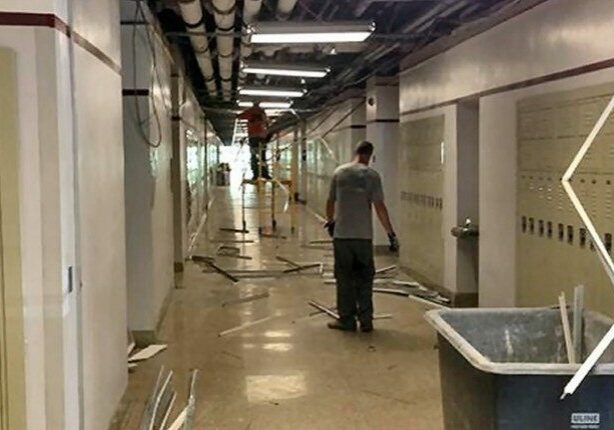Get involved now
If your school district is planning to do renovations, post-Sandy repairs, or new construction over the summer, now is an excellent time for the local association to become involved in protecting the health and safety of staff and students. Even if the local association hasn’t been involved in the planning stages, it is important to prepare for fall occupancy. Your local association can work with your UniServ fi eld representative to press for the following steps:
- It is desirable for newly repaired areas to be fl ushed out with 100% outdoor air for two weeks prior to occupancy, and increased outdoor air to be supplied for the fi rst 60 days after occupancy. This is particularly im- portant when new carpet, furnishings or particle board are in place, as these can all emit irritating, and in some cases toxic, vapors for some time.
- Engineers should test building construction and performance prior to entry, to ensure that the ventila- tion, heating and cooling, plumbing, lighting, electrical, security, and fi re protection systems are all working properly. They should issue a certifi – cate of occupancy.
- Staff and parents should have the opportunity for a walk-through inspection to confi rm that new and renovated areas are clean, odor-free, and have no visible mold (especially if the school suffered fl ood damage). It would be best to conduct the walkthrough after the weeks of fl ushing with fresh air.
In addition, you should be alert to problems or symptoms that may occur in the fi rst several months of occu- pancy, establish a system for reporting symptoms and educate staff about the system.
Involvement with construction and renovation is a good task for a local association health and safety committee (HSC) if you have one, and an opportunity for organizing one if you don’t, or strengthening an existing committee. Your UniServ fi eld repre- sentative can help you organize one.
If you will occupy a building during construction and renovation
Work may be ongoing during summer school or when school begins again in September. Repairs in an occupied building present further concerns, mainly about isolating the dust, vapors, and noise from the rest of the building. Again, it is important for local associations to be involved.
The best situation is for the local association to be in the loop before a project begins. The association (or HSC) can request meetings with all the players to ensure that occupied areas are safe during the work. Players include the New Jersey School Development Authority, which is responsible for school repairs; the New Jersey Department of Community Affairs, which establishes and enforces building codes and implements construction codes; the regional director and project offi cers, contractors and subcontractors, school administration and those in the district responsible for managing construction.
If you are occupying a building while work is underway, local associa- tions should check for the items listed below. Those recommendations that are required by standards are noted:
Before construction/renovation
- Hazardous materials should be removed from the building before renovations. These include asbestos, lead, mold, and bird and animal droppings. Removal should follow appropriate laws and guidelines.
- There should be an emergency plan to address construction-related emergencies such as fire, explosion, structural collapse, spills or other release of hazardous chemicals.
- Before using materials with potentially hazardous emissions (such as particle board, plywood, floor coverings, carpet backing, paint, adhesives, sealants, solvents, varnish, thinners, caulk, etc.) the employer must obtain toxicity information [Material Safety Data Sheets (MSDS)] and use it to select products and determine protective measures, including work methods, and protective equipment. (PEOSH IAQ standard)
- Employers should choose lowest toxicity products available and those that emit minimal hazardous vapors.
- The employer must assess the hazards of the chemical products in use, and provide and pay for appropriate respirators and personal protective equipment (PPE) for the workers doing the renovations and construction. (Respiratory Protection and PPE standards)
- Construction areas should be separated from occupied areas by fencing or other secure barriers and clearly marked with signs.
- A specifi c stairwell or elevator should be assigned to construction workers.
- The employer must notify employ- ees at least 24 hours in advance, or promptly in emergency situations, of potentially hazardous renovation work to be performed in a school building. (IAQ standard)
During the project
- Work that generates hazardous amounts of dust or gases should be safeguarded by means of local exhaust ventilation or other protective devices. Air contaminants, dust and debris must be confined to the renovation or construction area by means of physical barriers, negative pressure that draws air into the area and/ or performing work during periods of minimal occupancy. (IAQ standard)
- Good practices for dust control include wetting or using local exhaust ventilation to collect dust where it is produced, and cleanup by vacuuming and wet mopping/wiping. The area should be isolated from the school’s ventilation system and vents covered to prevent dust from entering the rest of the building. At the end of the project dust should be cleaned up with vacuums and wet mopping/ wiping.
- No construction traffic should be allowed during arrival and departure of staff and students. School buses and parent vehicles should be routed away from construction areas.
- Tools and machinery should be secured when not in use.
